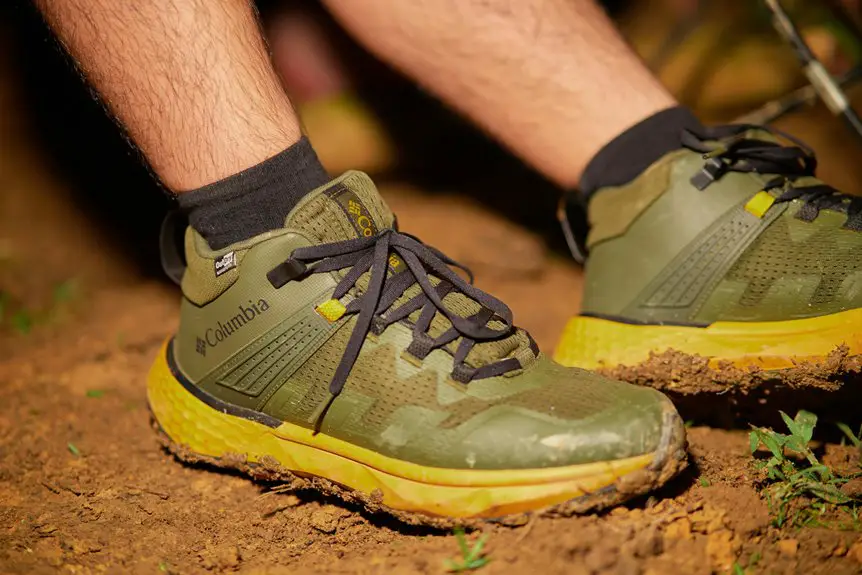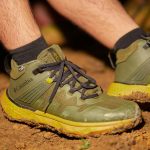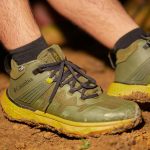Gore-Tex offers waterproof ratings typically ranging from 15,000mm to 28,000mm, depending on the product. For example, Gore-Tex Paclite and Active rate around 20,000mm, while Gore-Tex Pro reaches up to 28,000mm for the most demanding conditions. These “K” ratings indicate how much water pressure the fabric can withstand before leaking, so higher numbers mean better protection. If you want to understand how these ratings affect performance and which Gore-Tex suits your activity, there’s more to explore.
Table of Contents
Key Takeaways
- Gore-Tex waterproof ratings typically range from 15,000 mm to 28,000 mm (15K to 28K “K” rating).
- Gore-Tex Paclite and Gore-Tex Active have a 20,000 mm (20K) waterproof rating.
- Gore-Tex Pro offers the highest rating at 28,000 mm (28K) for rugged conditions.
- Gore-Tex Infinium products usually provide around 15,000 mm (15K) waterproofing.
- Higher “K” ratings indicate better water pressure resistance and more durable waterproofing.
Understanding the “K” Rating in Waterproof Fabrics
How do you know if a waterproof fabric can keep you dry in heavy rain? You look at its “K” rating, which measures waterproofness in millimeters.
This rating tells you how much water pressure the fabric can withstand before leaking. For example, a 10,000mm rating means the fabric can handle a 10-meter column of water pressing down on it without letting moisture through.
The higher the “K” number, the more waterproof the material is. Keep in mind, though, that a higher rating doesn’t always guarantee better comfort or breathability.
When choosing gear, balance the “K” rating with your activity level and weather conditions to stay dry and comfortable. Understanding this simple metric helps you pick the right waterproof fabric for your needs.
The Science Behind Gore-Tex Waterproofing
Now that you understand the meaning behind the “K” rating, it’s worth exploring how Gore-Tex achieves its waterproof performance.
The secret lies in its unique membrane, designed to keep water out while allowing moisture to escape. Here’s how it works:
Gore-Tex’s membrane blocks water but lets moisture escape, keeping you dry and comfortable.
- Microporous Structure – The membrane contains over 9 billion microscopic pores per square inch, too small for water droplets but large enough for vapor.
- Hydrophobic Coating – This repels liquid water, preventing it from penetrating the fabric.
- Durable Outer Layer – Protects the membrane from damage and helps shed water quickly.
- Seam Taping – Guarantees no water seeps through stitching points.
Typical Waterproof Ratings for Gore-Tex Materials
Wondering what waterproof ratings you can expect from Gore-Tex materials? Generally, they range between 20K and 28K mm, meaning they can withstand 20,000 to 28,000 millimeters of water pressure before leaking. Here’s a quick look at typical ratings for common Gore-Tex products:
| Gore-Tex Type | Waterproof Rating (mm) | Best Use |
|---|---|---|
| Gore-Tex Paclite | 20,000 | Lightweight jackets |
| Gore-Tex Active | 20,000 | High-intensity sports |
| Gore-Tex Pro | 28,000 | Rugged outdoor gear |
| Gore-Tex Infinium | 15,000 | Breathable shells |
| Gore-Tex C-Knit | 28,000 | Durable, breathable |
These ratings guarantee you stay dry in heavy rain or snow, no matter your adventure.
How Gore-Tex Compares to Other Waterproof Fabrics
You’ll want to see how Gore-Tex stacks up against other waterproof fabrics with regard to ratings, breathability, and durability.
Understanding these differences helps you pick the best gear for your needs.
Let’s compare how Gore-Tex performs on these key factors.
Waterproofing Ratings Comparison
Several popular waterproof fabrics compete with Gore-Tex, each offering different levels of water resistance measured in “K” ratings. When you compare them, it’s clear Gore-Tex balances high waterproofing with durability.
Here’s how they stack up:
- Gore-Tex: Typically around 28,000 mm, providing excellent protection in heavy rain.
- eVent: Close to 20,000 mm, known for strong waterproofing and breathability.
- HyVent (by The North Face): Around 15,000 mm, suitable for moderate weather conditions.
- DryVent (by The North Face): Ranges from 10,000 to 20,000 mm, offering versatility for various activities.
Understanding these ratings helps you pick the right fabric based on your needs, whether it’s intense storms or light showers.
Gore-Tex often leads but isn’t the only solid choice.
Breathability Versus Waterproofing
While waterproof ratings like Gore-Tex’s impressive 28,000 mm tell you how well a fabric keeps water out, breathability plays an equally important role in comfort.
Gore-Tex strikes a balance by allowing moisture vapor from sweat to escape, preventing that clammy feeling during intense activity. Compared to other waterproof fabrics, Gore-Tex often outperforms in breathability, thanks to its unique microporous membrane structure.
Some alternatives may block water effectively but trap heat and moisture inside, making you uncomfortable. When choosing gear, you must take into account both waterproofing and breathability to stay dry and comfortable.
Gore-Tex’s design guarantees you don’t have to sacrifice one for the other, which is why it remains a top choice for outdoor enthusiasts who demand reliable protection and ventilation.
Durability and Performance Differences
Although many waterproof fabrics offer solid protection, Gore-Tex stands out for its exceptional durability and consistent performance under harsh conditions. When you choose Gore-Tex, you get:
- Long-lasting waterproofing that doesn’t degrade quickly, even after repeated use.
- Superior resistance to abrasion, ensuring your gear withstands rough terrains.
- Reliable breathability, maintaining comfort by letting moisture escape while keeping water out.
- Consistent performance across varied temperatures and weather, so you stay protected no matter the environment.
Other fabrics might offer good initial waterproofing, but they often lose effectiveness faster or sacrifice breathability.
With Gore-Tex, you invest in gear that balances toughness and comfort, making it ideal for serious outdoor enthusiasts who need dependable protection day after day.
Factors Affecting Gore-Tex Waterproof Performance
You’ll find Gore-Tex’s waterproof performance depends heavily on the material composition and how the layers are constructed.
How you layer your gear also plays a big role in keeping water out.
Plus, environmental conditions like temperature and humidity can impact its effectiveness.
Material Composition Impact
Because Gore-Tex relies on a unique membrane structure, the specific materials used in its composition play an essential role in its waterproof performance.
When you evaluate Gore-Tex, consider these key material factors:
- Membrane Material: The expanded polytetrafluoroethylene (ePTFE) membrane provides microscopic pores that block water droplets but allow vapor to escape.
- Outer Fabric: Durable nylon or polyester layers protect the membrane from damage and impact waterproofing.
- DWR Coating: The durable water repellent finish prevents surface water absorption, enhancing breathability.
- Laminates: The number of layers (2L, 3L) influences flexibility and water resistance without compromising comfort.
Understanding these components helps you grasp why Gore-Tex maintains exceptional waterproofing while remaining breathable and durable in various conditions.
Layering Techniques Used
When you layer Gore-Tex materials, the arrangement considerably impacts its waterproof performance. You’ll want to position the Gore-Tex membrane as a middle layer, sandwiched between an outer protective shell and an inner moisture-wicking layer.
This setup shields the membrane from abrasion and keeps it dry inside, preserving its waterproof qualities. If you place Gore-Tex directly against your skin or beneath a heavy insulating layer, moisture can build up, reducing breathability and overall effectiveness.
Additionally, avoid layering bulky fabrics over Gore-Tex that trap water, as this increases pressure on the membrane and may cause leaks.
Environmental Condition Effects
Although Gore-Tex is designed to keep you dry, its waterproof performance can vary depending on environmental conditions.
You need to evaluate several factors that impact how well Gore-Tex holds up against water:
- Temperature: Extremely cold conditions can stiffen the membrane, reducing flexibility and breathability.
- Pressure: High water pressure, like heavy rain or submersion, tests the membrane’s limits and seam sealing.
- Wear and Tear: Dirt, oils, and abrasion can clog the membrane’s pores, decreasing effectiveness.
- Humidity: Very high humidity inside the garment can affect moisture vapor transmission, making you feel damp despite external waterproofing.
Interpreting Waterproof Ratings for Outdoor Gear
How do you make sense of waterproof ratings on outdoor gear? Those numbers, like 5K or 20K, indicate how much water pressure a fabric can withstand before leaking. For example, a 10K rating means the material resists 10,000 millimeters of water column. The higher the number, the better the waterproofing.
But don’t just look at the rating alone. Consider your activity and environment. A 5K jacket might suffice for light rain and casual hikes, while a 20K or higher is better for heavy storms and prolonged exposure.
Also, remember that waterproof ratings don’t guarantee breathability, so balance both based on your needs. Understanding these ratings helps you pick gear that keeps you dry without overheating.
Testing Methods for Waterproof Ratings
Since waterproof ratings directly impact your gear’s performance, understanding how manufacturers test these numbers is essential.
These tests simulate real-world conditions to guarantee your Gore-Tex gear holds up under pressure. Here’s how they typically do it:
- Hydrostatic Head Test: Measures water pressure your fabric resists before leaking, recorded in millimeters (e.g., 20,000 mm).
- Spray Test: Simulates rain hitting fabric at various angles and intensities, checking for water penetration.
- Seam Sealing Assessment: Evaluates if stitched areas prevent water from seeping through.
- Breathability Test: Measures moisture vapor transmission to confirm your gear stays comfortable.
Knowing these methods helps you pick gear that truly stands up to the elements, balancing waterproofing and breathability.
Maintenance Tips to Preserve Gore-Tex Waterproofing
To keep your Gore-Tex gear performing at its best, you need to care for it properly after each use. Start by gently cleaning your gear with lukewarm water and a mild soap to remove dirt and oils that can clog the membrane. Avoid fabric softeners and bleach, as they damage the waterproofing. Once dry, refresh the Durable Water Repellent (DWR) coating with a spray-on or wash-in treatment.
| Task | Tip |
|---|---|
| Cleaning | Use mild soap, avoid harsh chemicals |
| Drying | Air dry or tumble dry on low heat |
| Reapplying DWR | Use recommended products regularly |
Following these steps will extend your Gore-Tex’s waterproof life and keep you dry on every adventure.
Choosing the Right Gore-Tex Product for Your Needs
Wondering which Gore-Tex product fits your outdoor needs best? Start by considering your activity level and weather conditions.
Gore-Tex offers various options tailored for different uses. Here’s how to choose:
- Gore-Tex Paclite® – Ideal for lightweight backpacking and variable weather; packs small but stays durable.
- Gore-Tex Pro – Perfect if you need maximum durability and breathability during intense activities like climbing or skiing.
- Gore-Tex Active – Best for high-output sports where breathability is essential without sacrificing waterproofing.
- Gore-Tex Infinium™ – Suited for casual use and mild weather, focusing on comfort over full waterproof protection.
Match the product to your environment and activity to stay dry and comfortable.
Frequently Asked Questions
Can Gore-Tex Waterproofing Wear off Over Time?
Yes, Gore-Tex waterproofing can wear off over time, especially with heavy use or improper care. You should regularly clean and reapply a durable water repellent (DWR) treatment to maintain its waterproof performance.
Is Gore-Tex Environmentally Friendly?
You’ll find Gore-Tex is making strides toward being more environmentally friendly, using recycled materials and reducing harmful chemicals, but it’s not completely eco-friendly yet. Still, it’s improving sustainability with ongoing innovations.
How Does Gore-Tex Handle Breathability in Hot Weather?
Gore-Tex lets your sweat escape while blocking rain, so you stay dry and comfy in hot weather. You won’t feel sticky because it’s designed to breathe, keeping your body temperature balanced during intense activities.
Can Gore-Tex Be Repaired if Damaged?
If you tear your Gore-Tex jacket while hiking, you can repair it using specialized patches or repair kits. You’ll keep waterproofing intact, so you don’t have to replace your gear after minor damage.
What Is the Average Lifespan of Gore-Tex Garments?
You can expect Gore-Tex garments to last about 5 to 10 years with proper care. Regular cleaning and reapplying DWR treatments will help maintain their waterproofing and breathability over time.
- The Use of Nonwovens in Construction and Civil Engineering - July 11, 2025
- The Use of Nonwovens in Construction and Civil Engineering - July 11, 2025
- The Use of Nonwovens in Construction and Civil Engineering - July 11, 2025







